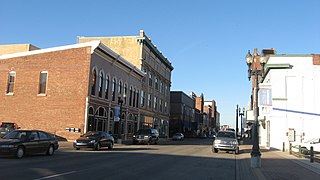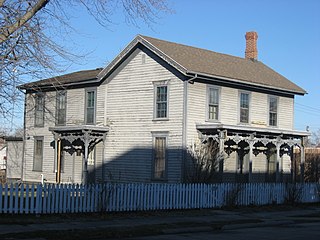
Chatham–Arch is a neighborhood located immediately east of Downtown Indianapolis, Indiana, United States. This neighborhood is one of the oldest in Indianapolis, dating back to the mid 19th century. Chatham–Arch contains many of Indianapolis's historic homes.

The Riverside Historic District is a U.S. historic district located in downtown Evansville, Indiana. It was added to the register in 1978 and roughly bounded by Southlane Drive, Walnut, Third, and Parrett Streets. It consists of 1,010 acres (4.1 km2) and 425 buildings. It is also known as the Riverside Neighborhood.

Beech Grove Cemetery is a large historical cemetery and national historic district located at Muncie, Indiana. It was listed on the National Register of Historic Places in 1999.

Brazil Downtown Historic District is a national historic district located at Brazil, Clay County, Indiana. The district encompasses 35 contributing buildings and two contributing objects in the central business district of Brazil. The district developed between about 1875 and 1935, and includes notable examples of Italianate, Romanesque Revival, and Renaissance Revival style architecture. Located in the district is the separately listed United States Post Office. Other notable buildings include the Sinclair Oil Gas Station, Lark Theater, Citizens Bank Building, Brazil Trust Company, D.H. Davis Building (1909), and Telephone Building.

Goldsmith C. Gilbert Historic District is a national historic district located at Muncie, Delaware County, Indiana. It encompasses 75 contributing buildings and is located in the oldest residential section of Muncie. The district includes notable examples of Late Victorian, Colonial Revival, and Bungalow / American Craftsman style architecture. Located in the district is the separately listed J.C. Johnson House. Other notable buildings include the A.L. Johnson House, Meeks Mortuary Building, Joseph Hummel House, and Miller Livery (1916).

Walnut Street Historic District is a national historic district located at Muncie, Delaware County, Indiana. It encompasses 66 contributing buildings and 1 contributing object, and is located in the central business district of Muncie. The district includes notable examples of Italianate, Late Victorian, Colonial Revival, and Beaux-Arts style architecture. Located in the district are the separately listed Moore-Youse-Maxon House, Roberts Hotel, and Goddard Warehouse. Other notable buildings include the Patterson Bock, McNaughton Block (1901-1903), Mitchell Block (1909), American National Bank Building (1924), Marsh Block (1888), and the Old Post Office designed by the Office of the Supervising Architect under James Knox Taylor.

Wysor Heights Historic District is a national historic district located at Muncie, Delaware County, Indiana. It encompasses 61 contributing buildings, 1 contributing site, and 1 contributing object in a predominantly residential section of Muncie. The district developed between about 1890 and 1930, and includes notable examples of Queen Anne, American Foursquare, and Bungalow / American Craftsman style architecture. Notable contributing resources include the equestrian sculpture and landscape ensemble "Appeal to the Great Spirit" by Cyrus Edwin Dallin (1929), Roy Thomas House (1922-1923), Burt Whiteley House (1892), and the first Delaware County Children's Home building.

Old West End Historic District is a national historic district located at Muncie, Delaware County, Indiana. It encompasses 273 contributing buildings in a predominantly residential section of Muncie. The district largely developed between about 1880 and 1915, and includes notable examples of Late Victorian style architecture. Notable buildings include Temple Beth-El (1922), First Church of Christ Scientist, Wittmore Apartments, Martin Sisters House (1879-1880), Christian Church / Wesleyan Chapel (1875), Vandercook House (1887), First English Lutheran Church, Muncie Hospital and Invalids Home (1890), and Ira Hunter House.

Westwood Historic District is a national historic district located at Muncie, Delaware County, Indiana. It encompasses 83 contributing buildings and 1 contributing site in a predominantly residential section of Muncie. The district developed after 1923, and includes notable examples of Colonial Revival, Tudor Revival, and Bungalow / American Craftsman style architecture. Notable buildings include the William H. Ball House (1925), Alexander Bracken House (1937), Michael Broderick House (1928), Bennett Heath House, and Fred Kencht House (1932).

Riverside Historic District is a national historic district located at Muncie, Delaware County, Indiana. It encompasses 74 contributing buildings and 1 contributing structure in a predominantly residential section of Muncie. The district developed between about 1895 and 1949, and includes notable examples of Colonial Revival, Tudor Revival, and Bungalow / American Craftsman style architecture.

Meeks Avenue Historic District is a national historic district located at Muncie, Delaware County, Indiana, USA. It encompasses 25 contributing buildings in a predominantly residential section of Muncie. The district developed between about 1904 and 1939, and includes notable examples of Bungalow / American Craftsman style architecture. A notable building is a service station constructed in 1939.

Minnetrista Boulevard Historic District is a national historic district in the city of Muncie, in Delaware County, East Central Indiana. It is located along the northeast side of Minnetrista Boulevard and the north bank of the White River, about a mile north of downtown Muncie.

The Moore–Youse–Maxon House, also known as the Moore–Youse Home Museum, is a historic home located at Muncie, Delaware County, Indiana. It was built about 1860, and is a two-story, three-bay, vernacular Greek Revival style frame dwelling. It features a rebuilt front porch with sawnwork and brackets. It has a two-story rear addition. The house remained in the same family from 1864 to 1982. The building is operated by the Delaware County Historical Society as a historic house museum.

Ellettsville Downtown Historic District is a national historic district located at Ellettsville, Monroe County, Indiana. The district encompasses 50 contributing buildings in the central business district and surrounding residential sections of Ellettsville. It developed between about 1840 and 1953, and includes notable examples of Queen Anne, Early Commercial, Gothic Revival, and Bungalow/American Craftsman style architecture. Notable buildings include the Robert Stimson House, May Presley House, Bradford House, George W. Fletcher House, Wickens House (1909), Capt. Gilbert Perry House, I.O.O.F. Building, Town Hall (1927), Masonic Building (1895), Knights of Pythias Building, First United Methodist Church (1900), and First Baptist Church (1909).

Rockville Historic District is a national historic district located at Rockville, Parke County, Indiana. The district encompasses 210 contributing buildings, 3 contributing structures, and 1 contributing object in the central business district and surrounding residential sections of Rockville. It developed between about 1826 and 1942, and includes notable examples of Italianate, Colonial Revival, and Queen Anne style architecture. Notable contributing resources include the Parke County Courthouse (1882), Memorial Presbyterian Church (1891), Sheriff' Residence and Jail, U.S. Post Office (1938), Rockville Public Library (1916), Methodist Episcopal Church, Rockville Grade School (1941), Parke County Seminary (1839), Rockville Opera House (1912), First National Bank (1907), Judge Samuel Maxwell House, Dr. P.Q. Stryker House (1838), Dr. Harrison J. Rice House (1880), and Dr. Marion Goss House (1907).

Ninth Street Hill Neighborhood Historic District is a national historic district located at Lafayette, Tippecanoe County, Indiana. The district encompasses 88 contributing buildings and 6 contributing structures in a predominantly residential section of Lafayette. It developed between about 1850 and 1946 and includes representative examples of Gothic Revival, Italianate, Queen Anne, Greek Revival, and Second Empire style architecture. Located in the district is the separately listed Judge Cyrus Ball House. Other notable contributing resources include the Samuel Moore House (1891), Moore-Porter-Boswell House (1895), Stanley Coulter House (1890), Edward Bohrer House (1909), Thomas Wood House, Job M. Nash House (1859), and Gordon Graham House.

West Wabash Historic District is a national historic district located at Wabash, Wabash County, Indiana. It encompasses 283 contributing buildings in a predominantly residential section of Wabash. It developed between about 1840 and 1930, and includes representative examples of Federal, Italianate, Romanesque Revival, and Colonial Revival style architecture. Located in the district is the separately listed First Christian Church. Other notable buildings include the Jackson Family House, John and Lucinda Sivey House, Thomas and Hannah Whiteside House (1881), Matlock-Barnhart House (1866–1867), Alexander and Millicent Hill House, David and Sadie Cohen House (1909), Bennett E. Davis House (1842), Presbyterian Church (1881), Wabash Carnegie Public Library, and Wabash High School.

North Meridian Street Historic District is a national historic district located at Indianapolis, Indiana. It encompasses 169 contributing buildings in a high style residential section of Indianapolis. The district developed between about 1900 and 1936, and includes representative examples of Tudor Revival, Colonial Revival, and Classical Revival style architecture. Located in the district is the separately listed William N. Thompson House. Other notable contributing resources include the Evan-Blankenbaker House (1901), Sears-Townsend House (1930), MacGill-Wemmer House, Hugh Love House (1930), Hare-Tarkington House (1911), Shea House (1922), and Brant-Weinhardt House (1932).

Holy Rosary–Danish Church Historic District, also known as Fletcher Place II, is a national historic district located at Indianapolis, Indiana. The district encompasses 183 contributing buildings in a predominantly residential section located in the central business district of Indianapolis. It was developed between about 1875 and 1930, and include representative examples of Italianate, Gothic Revival, Tudor Revival, and Renaissance Revival style architecture. Located in the district is the separately listed Horace Mann Public School No. 13. Other notable buildings include the John Kring House, Trinity Danish Evangelical Lutheran Church (1872), John Wands House (1857), Henry Homburg House, Samuel Keely House, Maria Wuensch Cottage, and Holy Rosary Catholic Church (1911-1925).

Shortridge–Meridian Street Apartments Historic District is a national historic district located at Indianapolis, Indiana. The district encompasses 136 contributing buildings in a predominantly residential section of Indianapolis. It was developed between about 1900 and 1951, and includes representative examples of Colonial Revival, Classical Revival, Late Gothic Revival, Mission Revival, Renaissance Revival, Bungalow / American Craftsman, and Art Deco style architecture. Located in the district is the separately listed Shortridge High School. Other notable buildings include the Vernon Court Apartments (1928), Fronenac Apartments (1951), Biltmore Apartments (1927), Meridian Apartments (1929), New Yorker Apartments (1917), Howland Manor (1929), Powell-Evans House (1911), Harms House (1906), Dorchester Apartments (1921), and Martin Manor Apartments (1916).
























